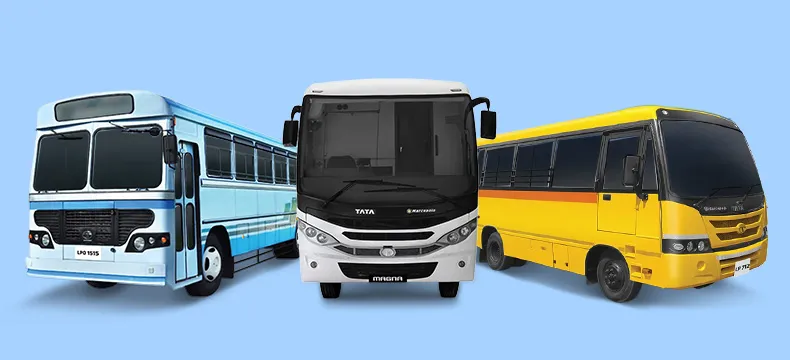17 Sep 2025

Microbuses: The Ideal Solution for Urban Transportation
- Tata Motors
- 12 Feb 2025
- COMMERCIAL VEHICLE
Introduction
In cities worldwide, transportation can often be challenging, especially when it comes to crowded streets and high demand for public transport. Microbuses have emerged as a perfect solution for businesses, schools, and organisations in urban areas. Offering a compact size and efficient functionality, these vehicles are becoming a popular choice for local transportation needs. This blog will explore micro buses, their benefits, and why they are the ideal choice for urban transportation.
What Are Micro Buses?
A micro bus is a smaller version of a traditional bus designed to carry fewer passengers, typically 10 to 20 seats. Due to their size, microbuses are ideal for urban transportation, making them more manoeuvrable in congested city streets. Whether used for staff transport, school runs, or shuttle services, micro buses offer a great alternative to larger vehicles in crowded urban environments.
Advantages and Benefits of Micro Buses in Urban Transportation
Microbuses provide several advantages when navigating the complexities of urban transportation, making them a smart choice for businesses and organisations.
1. Compact Size for Better Maneuverability
One of the primary benefits of micro buses is their compact size, which allows them to easily navigate narrow city streets and tight corners. Unlike larger buses that may struggle with traffic or limited parking space, micro buses can access typically inaccessible areas for bigger vehicles, ensuring smooth and timely transport.
2. Efficient Fuel Consumption
Micro buses are designed to be fuel-efficient, offering businesses and organizations a cost-effective solution for their transportation needs. Due to their smaller size and lighter weight, these buses typically consume less fuel than larger vehicles, making them an economical choice for daily operations in urban areas.
3. Ideal for Smaller Groups
Whether running a corporate shuttle service or transporting school children, micro buses provide the perfect capacity for small to medium-sized groups. They offer a comfortable and safe ride without operating larger, more costly vehicles that might be underutilised
4. Lower Operating Costs
Microbuses are less expensive than larger ones. These vehicles generally have lower maintenance and insurance costs, as well as lower upfront purchasing costs. This makes them a budget-friendly solution for organisations looking to offer transport services in urban settings without the financial burden of larger fleet vehicles.
5. Reduced Traffic Congestion
Smaller commercial vehicles like micro buses help reduce overall traffic congestion in urban areas. Their ability to hold fewer passengers while taking up less space on the road contributes to less crowded streets and a smoother flow of traffic, which benefits everyone.
6. Environmentally Friendly
Micro buses often have lower emissions than larger buses, making them a greener choice for cities focused on sustainability. By investing in these smaller, more eco-friendly vehicles, businesses and municipalities can contribute to reducing the carbon footprint of urban transportation.
7. Enhanced Passenger Comfort
Despite their compact size, micro buses are designed to offer a high level of comfort for passengers. These vehicles typically feature air-conditioning, ample seating, and smooth rides, ensuring passengers enjoy a pleasant and comfortable journey, whether commuting to work or attending school.
Micro Bus Uses and Applications
Micro buses are highly versatile and can be used for various purposes in urban environments. Here are some of the most common applications:
-
Staff Transport:
Companies often use micro buses to transport employees between office locations or to and from work. This provides employees with a reliable and convenient mode of transportation.
-
School Transportation:
Many schools use microbuses to transport students safely and efficiently. Their small size allows them to navigate busy school zones and residential areas.
-
Shuttle Services:
Hotels, airports, and event venues frequently use micro buses to shuttle guests and passengers between locations, offering a more personalised service than larger buses.
-
Tourist Transportation:
Tour operators use micro buses for city tours or group sightseeing trips, which provide tourists with a more intimate and comfortable experience than standard tour buses.
Conclusion
In bustling urban environments, micro buses offer a practical, efficient, and cost-effective solution for transportation needs. Their compact size, fuel efficiency, and flexibility make them an excellent choice for organisations that require a vehicle for transporting small groups. Microbuses are a reliable and environmentally friendly choice for employee shuttles, school runs, or tourism. Microbuses are worth exploring if you consider adding a vehicle to your fleet.
FAQ
What Are Micro Buses?
A microbus is a compact, smaller version of a traditional bus, typically seating 10 to 20 passengers. Due to their maneuverability and fuel efficiency, microbuses are ideal for urban transportation.
How are Micro Buses Used in Urban Transportation?
Micro buses are commonly used for staff transport, school buses, shuttle services, and city tours. Their compact size allows them to navigate through narrow urban streets with ease.
What Are the Benefits of Using Micro Buses in Cities?
Micro buses help reduce traffic congestion, offer cost-effective transportation, and provide a more comfortable and eco-friendlier ride. They are ideal for small to medium-sized groups in urban areas.
What Are the Advantages of Using Micro Buses for Urban Transportation?
Some key advantages include their compact size, which improves manoeuvrability, lowers operating costs and fuel efficiency and reduces environmental impact.
What Is the Typical Size and Capacity of a Micro Bus?
Depending on the model, a typical microbus can accommodate between 10 and 20 passengers. These buses are designed to be compact yet spacious enough for small groups.
- Tags
Latest Blogs


10 Sep 2025
What Exactly Is Torque in A Truck Engine?

10 Sep 2025


















